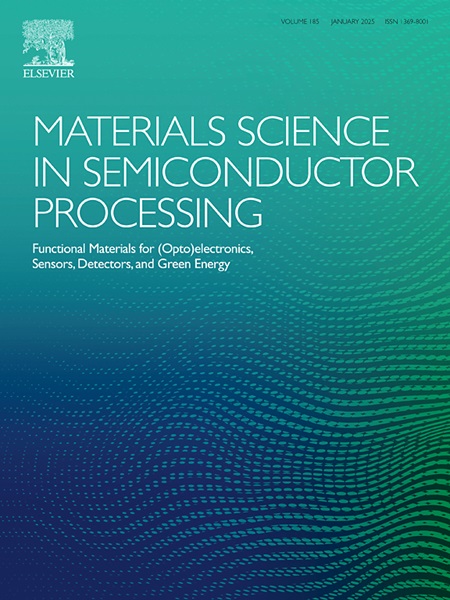Potential of two-dimensional AgAlP2Se6 monolayer for high-efficiency photocatalytic hydrogen production
IF 4.2
3区 工程技术
Q2 ENGINEERING, ELECTRICAL & ELECTRONIC
引用次数: 0
Abstract
In recent years, two-dimensional (2D) photocatalytic materials have garnered significant attention from researchers because of their high specific surface area and numerous active sites for photocatalytic reactions. However, many 2D photocatalytic materials exhibit low photogenerated carrier mobility and easy recombination of photogenerated electron-hole pairs, leading to poor photocatalytic performance. In this study, we propose and investigate AgAlP2Se6 monolayers theoretically for the first time. Through first-principle calculations, we find that AgAlP2Se6 monolayers possess good mechanical, thermal, and kinetic stabilities and exhibit a high carrier utilization rate. The electron mobility of the AgAlP2Se6 monolayer is 14.77 times higher than the hole mobility. This significant mobility difference helps to inhibit the recombination of electron-hole pairs, thereby improving photocatalytic efficiency. The solar-to-hydrogen conversion efficiency (STH) reaches 18.10 %, significantly exceeding the critical value (10 %) for the commercial application of photocatalytic water decomposition. Therefore, we predict that AgAlP2Se6 monolayers are a promising photocatalytic material capable of playing a significant role in photocatalytic water decomposition and other fields.
二维 AgAlP2Se6 单层在高效光催化制氢方面的潜力
近年来,二维(2D)光催化材料因其比表面积大、光催化反应活性位点多而备受研究人员关注。然而,许多二维光催化材料表现出光生载流子迁移率低、光生电子-空穴对易重组等问题,导致光催化性能不佳。在本研究中,我们首次提出并从理论上研究了 AgAlP2Se6 单层。通过第一性原理计算,我们发现 AgAlP2Se6 单层具有良好的机械稳定性、热稳定性和动力学稳定性,并表现出较高的载流子利用率。AgAlP2Se6 单层的电子迁移率是空穴迁移率的 14.77 倍。这种显著的迁移率差异有助于抑制电子-空穴对的重组,从而提高光催化效率。太阳能到氢气的转化效率(STH)达到了 18.10%,大大超过了光催化水分解商业应用的临界值(10%)。因此,我们预测 AgAlP2Se6 单层是一种前景广阔的光催化材料,能够在光催化水分解和其他领域发挥重要作用。
本文章由计算机程序翻译,如有差异,请以英文原文为准。
求助全文
约1分钟内获得全文
求助全文
来源期刊

Materials Science in Semiconductor Processing
工程技术-材料科学:综合
CiteScore
8.00
自引率
4.90%
发文量
780
审稿时长
42 days
期刊介绍:
Materials Science in Semiconductor Processing provides a unique forum for the discussion of novel processing, applications and theoretical studies of functional materials and devices for (opto)electronics, sensors, detectors, biotechnology and green energy.
Each issue will aim to provide a snapshot of current insights, new achievements, breakthroughs and future trends in such diverse fields as microelectronics, energy conversion and storage, communications, biotechnology, (photo)catalysis, nano- and thin-film technology, hybrid and composite materials, chemical processing, vapor-phase deposition, device fabrication, and modelling, which are the backbone of advanced semiconductor processing and applications.
Coverage will include: advanced lithography for submicron devices; etching and related topics; ion implantation; damage evolution and related issues; plasma and thermal CVD; rapid thermal processing; advanced metallization and interconnect schemes; thin dielectric layers, oxidation; sol-gel processing; chemical bath and (electro)chemical deposition; compound semiconductor processing; new non-oxide materials and their applications; (macro)molecular and hybrid materials; molecular dynamics, ab-initio methods, Monte Carlo, etc.; new materials and processes for discrete and integrated circuits; magnetic materials and spintronics; heterostructures and quantum devices; engineering of the electrical and optical properties of semiconductors; crystal growth mechanisms; reliability, defect density, intrinsic impurities and defects.
 求助内容:
求助内容: 应助结果提醒方式:
应助结果提醒方式:


